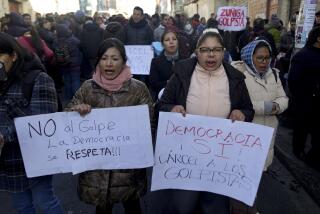WORLD REPORT EXTRA: The Coup and Beyond : Anatomy of an Attempted Coup
- Share via
How It Began
Soviet President Mikhail S. Gorbachev faced conservative opposition from the moment he began political and economic reforms six years ago. But until Monday, he seemed to keep opponents in check with adroit political maneuvers. A new union treaty that will formally decentralize power among the country’s constituent republics was apparently the last straw for the rightists. Just four days before it was to be signed, longtime Gorbachev adviser Alexander N. Yakovlev quit the Communist Party and warned that a “Stalinist” coup was brewing.
The Rightists Move
Coup organizers moved as Gorbachev was about to fly back from a Crimean vacation for the treaty-signing ceremony. They detained him and announced via the official Tass news agency at dawn Monday that the president was being replaced for health reasons. Vice President Gennady I. Yanayev was named chairman of an Emergency Committee of eight known right-wingers--including chiefs of the Soviet army, KGB, and police--who declared a state of emergency.
Yeltsin’s Gamble
Russian President Boris N. Yeltsin, who had made a career in recent years of accusing his onetime mentor, Gorbachev, of moving too slowly on reforms, immediately denounced the plotters, called for a nationwide protest strike, and urged soldiers to ignore Emergency Committee orders. By far the most important, freely elected official in the country, Yeltsin turned his Russian Federation government headquarters into the focus of resistance. Tens of thousands of supporters and some defecting army units surrounded the building, turning themselves into human shields between the barrel-chested Siberian and the armored troops backing the rightists.
The Turning Point
Many analysts contend that the plot was doomed from the beginning by poor organization and planning. In any event, the coup leaders were clearly thrown off balance by the show of popular opposition, mutinies by some army units and the deaths of at least four civilians in clashes with troops. Nearly universal worldwide criticism of their actions, an immediate cutoff of Soviet aid by several Western nations and clear support for Yeltsin and Gorbachev expressed by President Bush and other leaders also proved that the price of their coup would be high.
The Current Status
Back in the Kremlin, Gorbachev has proclaimed he is again in control. The former defense minister and the head of the KGB, two of the plotters, have been fired and replacements named. The former interior minister has committed suicide. Other coup leaders are reported arrested. At a Moscow press conference, Gorbachev reveals details of his ordeal. Huge crowds celebrate in the streets of the capital. But as the Soviet Union returns to some semblance of normal life, it is Yeltsin and not Gorbachev who appears to have emerged as the most powerful man in the country.
What Next?
Watch for Gorbachev to try to reassert his authority even as Yeltsin, with his extraordinary popular support, effectively sets the national agenda. There is bound to be a historic reckoning within discredited Soviet institutions such as the KGB, and the Communist Party. Central television and the party newspaper Pravda, seen as supporting the plotters, face shake-ups. The plotters will be prosecuted, the collaborators purged and the silent shunted aside. Look for a more radical approach to economic reform to be proclaimed. The Union Treaty will be back on the agenda. But given the key role played by Yeltsin and his Russian Federation in foiling the plotters and the obvious disarray in the organs of central power that the coup underlined, there’s likely to be some renegotiation to devolve even more powers to the republics.
More to Read
Sign up for Essential California
The most important California stories and recommendations in your inbox every morning.
You may occasionally receive promotional content from the Los Angeles Times.












